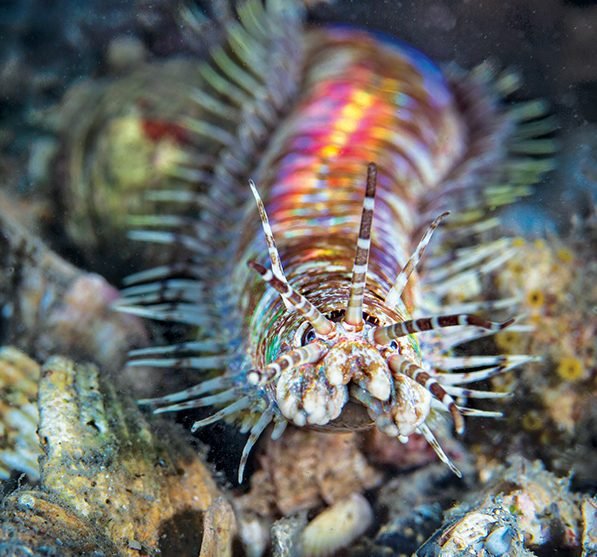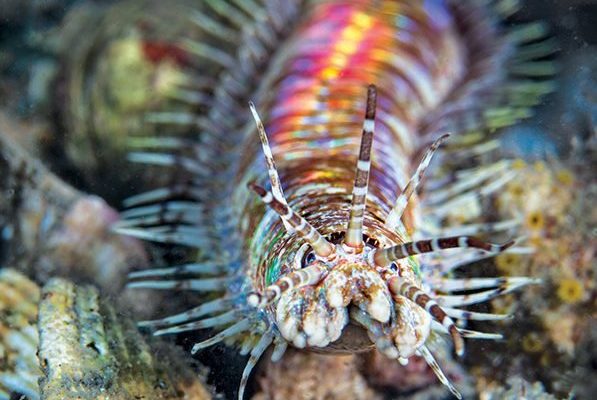
Let’s dive into the world of the Bobbit worm and explore how its coloration and camouflage techniques help it survive and thrive in the deep blue sea. We’ll discover not just how these worms manage to blend into their environment, but also why these traits are crucial for their hunting and protection.
What is a Bobbit Worm?
The Bobbit worm, scientifically known as *Eunice aphroditois*, can give you a real shock if you stumble upon one. These worms can grow up to 10 feet long and have a body that’s segmented like an earthworm but packed with a lot more flair. They’re typically found in tropical waters, buried deep in the sand or under rocks, just waiting for unsuspecting fish to swim by.
What’s truly captivating about the Bobbit worm is its head, which is adorned with long, colorful tentacles. These tentacles are often bright green, blue, or even red, allowing the worm not just to look stunning but also to snatch up prey quickly. When you see one, you might think you’ve come across a bizarre underwater flower.
The Role of Coloration in Survival
So, why does the Bobbit worm have such vibrant colors? You might think that bright colors make it easier for predators to spot them, but here’s the thing: those vivid hues serve multiple purposes. For starters, the bright colors can help them blend in with the vibrant corals and sea anemones. This means they can camouflage themselves effectively, making it harder for predators to notice them while they’re resting.
Also, those colors can be a warning to potential threats. Many brightly colored creatures in the ocean are toxic, so the Bobbit worm’s bold look might signal to predators that it’s not a good idea to take a bite. It’s like wearing a “do not eat” sign, helping the worm stay safe while looking fabulous.
Camouflage Techniques of the Bobbit Worm
Camouflage is where the Bobbit worm truly shines. It’s not just about having flashy colors; it’s about how they use their environment. Bobbit worms often burrow into the ocean floor, leaving only their colorful heads exposed. This can make them look like part of the reef or surrounding sand, which is a smart survival technique.
Another fascinating aspect is how they position their bodies. When they sense movement, they can quickly retract into their burrow, almost disappearing from sight. If you were watching, you’d see a bright flash of color vanish in an instant! This ability gives them an edge, allowing them to stay hidden from both prey and predators alike.
Adaptive Behaviors in Different Environments
Different environments can change how the Bobbit worm utilizes its coloration and camouflage. In coral-rich areas, you might find them flaunting their colors more, as the vibrant background enhances their disguise. But in sandier or rockier substrates, they might tuck away their colorful tentacles, opting for a more earth-toned appearance. It’s like changing outfits to suit the occasion!
This adaptive behavior shows how versatile these worms can be. They’re not stuck in one mode of survival; they can switch things up based on where they are. This flexibility is key to thriving in diverse marine environments.
How Camouflage Affects Their Hunting Techniques
You might wonder how all these camouflage techniques help the Bobbit worm when it comes to hunting. Well, they’re quite the ambush predators! By blending into their surroundings, they can wait patiently for fish or shrimp to swim too close. When the time is right, they strike with incredible speed, using their strong jaws to grab their prey before it even knows what hit it.
This method of hunting is incredibly effective. It’s like playing hide-and-seek but with a delicious reward at the end! Thanks to their coloration and camouflage, Bobbit worms can often catch prey that would otherwise swim by unnoticed.
The Importance of Camouflage in Marine Ecosystems
Camouflage is more than just a neat trick for the Bobbit worm; it plays a vital role in the health of marine ecosystems. By helping them avoid predators, these worms can maintain balanced populations, which is essential for the health of coral reefs. When one species thrives, it can affect the entire ecosystem, including the fish and other organisms that depend on healthy coral habitats.
Moreover, the Bobbit worm’s hunting habits help control the populations of smaller fish and crustaceans, ensuring that no single species dominates. This balance is crucial for maintaining biodiversity in marine habitats, proving that something as simple as camouflage can have far-reaching effects.
The Bobbit worm’s coloration and camouflage techniques are remarkable achievements of nature. Their ability to blend into their environment not only protects them but also supports the intricate balance of marine ecosystems. Whether they’re flaunting their vibrant colors or hiding away in a burrow, these worms truly embody the art of survival in the underwater realm.
Next time you think of vibrant ocean life, remember the Bobbit worm—nature’s colorful masterpiece. They remind us of the beauty and complexity of life beneath the waves, each color and technique serving a purpose in the grand tapestry of the ocean.

